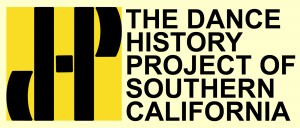Agnes de Mille, September 18, 1905 – October 7, 1993, was an innovative choreographer and dancer. The daughter of William deMille and niece of Cecil B. DeMille, both Hollywood directors, Agnes de Mille’s early aspiration was to be an actress. She turned her attention to dance when her sister began to take lessons, although she did not decide to pursue dance professionally until after college. De Mille faced resistance in pursuing both theater and dance. She was told she was not “pretty enough” to be an actress and not flexible enough to be a classical dancer. However, by growing up on and around Hollywood sets, de Mille developed strong character work and performances, which she later successfully brought into her dance and choreography.
She earned her degree in English from UCLA, and in 1933 moved to London to study with Marie Rambert. While in London, she danced with Rambert’s company, The Ballet Club (later Rambert Ballet) and Antony Tudor’s London Ballet.
Her first significant work, Rodeo, was choreographed in 1942 for the Ballet Ruse de Monte Carlo. The success of Rodeo led de Mille to Broadway opportunity and success after she was invited to choreograph Oklahoma!. Some of her most successful Broadway choreographies included: Oklahoma! (1943), Bloomer Girl (1944), Carousel (1945), Brigadoon (1947), Gentlemen Prefer Blondes (1949), Paint Your Wagon (1951), The Girl in Pink Tights (1954), Goldilocks (1957), and 110 in the Shade (1963). One of the significant qualities of de Mille’s choreography was its ability to add context to characters by conveying emotional turmoil or development rather than serving only as a divertissement.
De Mille continued to choreography for concert dance as well. In 1939 she developed professional relations with the new American Ballet Theater, then known as Ballet Theater, as a charter member. Many of her works were produced and performed by American Ballet Theater including Black Ritual, the first work that featured black dancers performed by a major ballet company and Three Virgins and a Devil (1934). She choreographed her final work, The Other, in 1992.
In 1973 she formed the Heritage Dance Theater in conjunction with the North Carolina School for the Arts. In her later years, de Mille took to writing, and published over 10 books in American dance history. De Mille has been honored for her many contributions to dance and theater in her lifetime. Her awards include: two Tony Awards, one Emmy, New York City Handel Medallion (1976), Kennedy Center Honor by President Carter (1980), and honorary doctorates.
Further Reading:
Biography by Gemze de Lappe, New York Theater Ballet:
http://www.nytb.org/images/demille-guide2.pdf
Biography by American Ballet Theater Foundation:
http://www.abt.org/education/archive/choreographers/de_mille.html
Biography by Kennedy Center:
http://www.kennedy-center.org/explorer/artists/?entity_id=3719&source_type=A
Obituary: Anderson, Jack. “Agnes de Mille, 88, Dance Visionary, is Dead.” The New York Times, October 8, 1993.
http://www.nytimes.com/1993/10/08/obituaries/agnes-de-mille-88-dance-visionary-is-dead.html
Wikipedia: “Agnes de Mille”:
http://en.wikipedia.org/wiki/Agnes_de_Mille
Contribute to The Dance History Project of Southern California.
Add a bio, recollection, and more.
If you represent Agnes de Mille or have material relevant to the artist, we invite you to contribute.
Update information for Agnes de Mille >>





Recent Comments